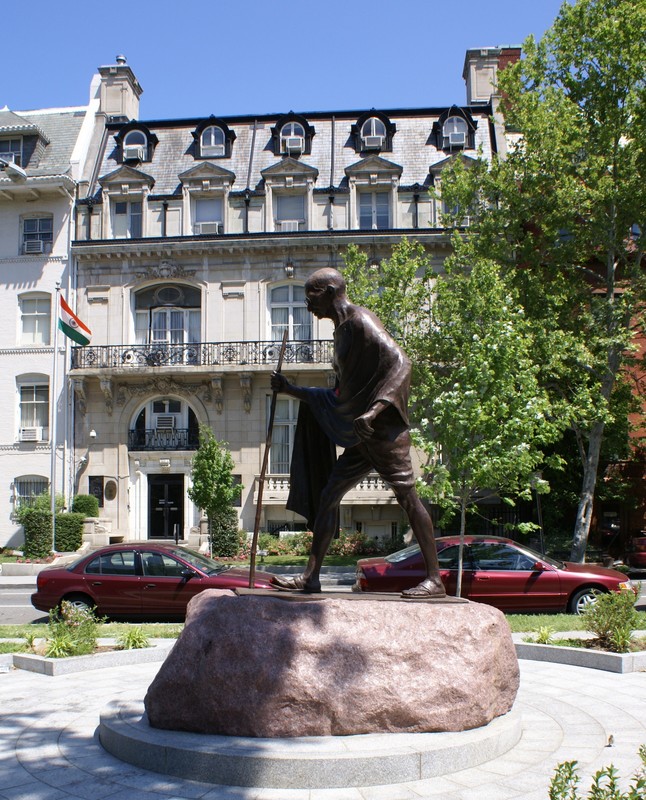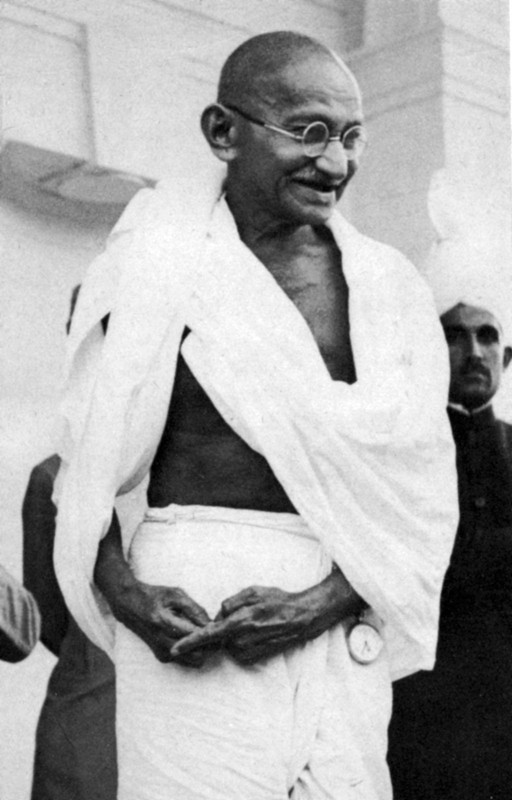Mahatma Gandhi Memorial
Introduction
Text-to-speech Audio
Images
Mahatma Gandhi Memorial across from the Indian embassy in Washington, D.C.

Mohandas Gandhi (1869-1948)

Backstory and Context
Text-to-speech Audio
Mohandas Karamchand Gandhi (known also as Mahatma Gandhi) was born to a well-to-do family in the city of Porbandar in British India on October 2, 1869. At the age of eighteen, he went to England to pursue legal studies. After completing his law degree, Gandhi returned to his homeland in 1891 with the hope of putting his legal training to use. After years of struggling to find a job, he finally accepted a temporary position in South Africa in 1893. Gandhi’s time there proved to be an eye-opening and influential period in his life. While living in South Africa, the young Indian lawyer experienced firsthand the overt racism and discriminatory laws directed toward non-whites. On one occasion, which he later referred to as a watershed in his life, Gandhi was kicked off a train after refusing to leave a first-class, whites-only passenger car and move to another compartment. While spending the night in the freezing cold waiting room of the train station at Pietermaritzburg, he decided to devote himself to fighting injustice. In the following years, Gandhi moved to organize the minority Indian community in South Africa. It was during this time that he also developed his philosophy of nonviolent civil disobedience. Gandhi’s social activism kept him in South Africa until 1914, when he returned to India.
From 1919 to 1948, Gandhi peacefully protested the injustices suffered by Indians under the British Raj. After British authorities issued laws that allowed for Indians suspected of sedition to be jailed without trial, he called for a national day of fasting and a work stoppage. In 1930, Gandhi led a 200-mile march to the coast, where he and others made salt from seawater in defiance of a British law that forbade Indians from manufacturing salt. Taxes on salt helped to fund the British colonial government. Gandhi’s actions inspired tens of thousands of Indians to do the same in protest. In the 1940s, he went on a hunger strike to protest the treatment of India’s “untouchables.” This led to a 1947 resolution that made it illegal to discriminate against that particular caste of persons. During this period, most significantly, Gandhi called for an end to British rule in India, becoming the leader of the Indian independence movement. He also worked assiduously to promote peace and understanding between Hindus and Muslims. Indian independence from Great Britain finally came in 1947, but religious strife between Hindus and Muslims continued. The following year, on January 30, while on his way to a prayer meeting in New Delhi, Gandhi was assassinated by a Hindu extremist angered by Gandhi’s cooperation with, and tolerance for, Muslims.
In 1997, India marked the fiftieth anniversary of its gaining independence from Great Britain. On the heels of the celebration, the Indian embassy and Indian-Americans living across the United States lobbied to have a memorial to Gandhi erected on federal land in Washington, D.C. Their efforts paid off in October 1998 when Congress passed the necessary legislation. Soon after, President Clinton signed the bill into law. Dedicated in September 2000 on a triangular traffic island across from the Indian embassy, the memorial consists of a larger-than-life-sized bronze statue of Gandhi on a roughly-hewn pedestal of Indian ruby red granite. Designed by Indian sculptor Gautam Pal, the nearly nine-foot-tall statue depicts leader of the Indian independence movement walking with a staff. A gift to the United States from the Indian Council for Cultural Relations, the memorial sits on a small circular plaza within the traffic island. Paved with grey granite, the plaza features a five-foot-long bench and three informational panels, all made of Indian ruby red granite. In attendance at the memorial’s unveiling ceremony was President Clinton and Indian Prime Minister Atal Bihari Vajpayee, who at the time was on a state visit to the United States.
Sources
"Gandhi, Mohandas K." The Martin Luther King, Jr. Research and Education Institute. Stanford University. Web. 16 February 2021 <https://kinginstitute.stanford.edu/encyclopedia/gandhi-mohandas-k>.
History.com Editors. "Mahatma Gandhi." History. A&E Television Networks. 6 June 2019. Web. 16 February 2021 <https://www.history.com/topics/india/mahatma-gandhi>.
Leonard, Thomas M., ed. Encyclopedia of the Developing World. Vol. 2, F-N. New York: Routledge, 2006.
"Site of the Memorial & the Memorial Plaza. Embassy of India, Washington, D.C., U.S.A. Ministry of External Affairs. Government of India. Web. 16 February 2021 <https://www.indianembassyusa.gov.in/memorial?id=20>.
"The Statue and Pedestal." Embassy of India, Washington, D.C., U.S.A. Ministry of External Affairs. Government of India. Web. 16 February 2021 <https://www.indianembassyusa.gov.in/memorial?id=21>.
https://en.wikipedia.org/wiki/Mahatma_Gandhi_Memorial_(Washington,_D.C.)
https://www.britannica.com/biography/Mahatma-Gandhi
